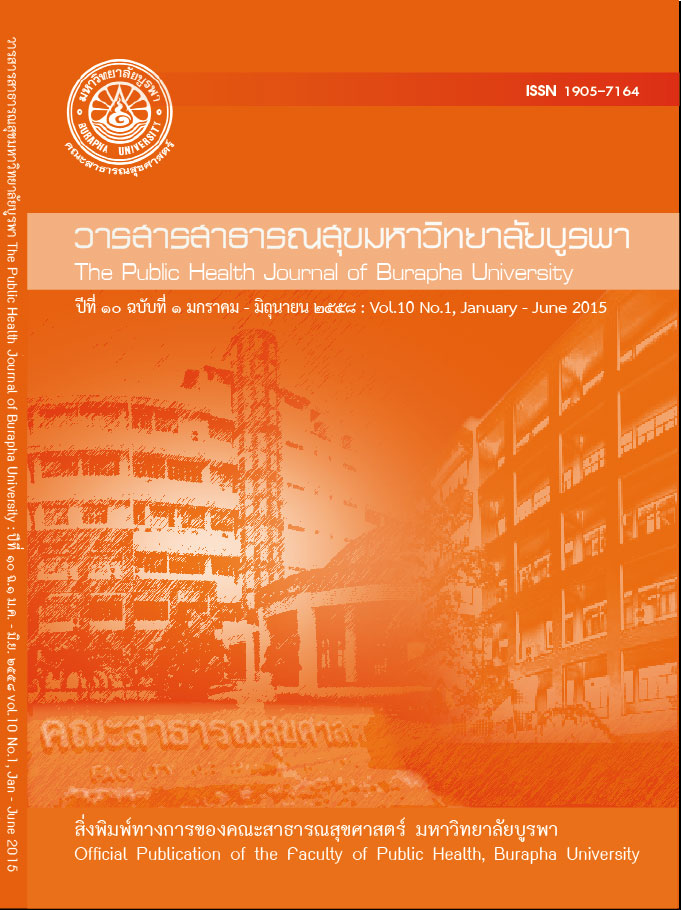Development of Information Management System for Chemica Incident Preparedness and Response Application on ALOHA, MARPLOT, Google Earth and Microsoft Excel
Main Article Content
บทคัดย่อ
ชรินทร์ เย็นใจ* วันเพ็ญ วิโรจนกูฏ**
*วิทยาลัยการสาธารณสุขสิรินธร จังหวัดชลบุรี **คณะวิศวกรรมศาสตร์ มหาวิทยาลัยขอนแก่น
การศึกษาครั้งนี้เป็นการจัดการระบบฐานข้อมูลเพื่อรองรับสถานการณ์สารเคมีรั่วไหล ด้วยโปรแกรมคอมพิวเตอร์สำเร็จรูป ALOHA (Areal Locationsof Hazardous Atmospheres) และMARPLOT (Mapping Applicationfor Response Planningand Operational Tasks) โดยจำลองสถานการณ์การรั่วไหลของเบนซีน (Benzene) และสไตรีน (Styrene) จากโรงงาน ปิโตรเคมีจำนวน 1,728 สถานการณ์ แสดงผลบนแผนที่ดาวเทียมจากโปรแกรม Google Earth ในรูปของพื้นที่การแพร่กระจายของสารเคมีและความเข้มข้นของสารเคมีในแต่ละจุด นอกจากนี้แล้ว ระบบฐานข้อมูลยังประกอบด้วยข้อมูลความปลอดภัยด้านเคมีภัณฑ์(MSDS) ข้อมูลผู้เชี่ยวชาญ เกี่ยวกับสารเคมีและข้อมูลหน่วยงานที่ต้องรายงานเมื่อเกิดสถานการณ์ฉุกเฉินจากสารเคมีรั่วไหล ข้อมูลทั้งหมดจะถูกจัดเตรียมเก็บไว้อย่างเป็นระบบทั้งในแบบไฟล์รูปภาพ และไฟล์เอกสาร พร้อม ที่จะเรียกใช้เพื่อเป็นข้อมูลตอบโต้สถานการณ์ฉุกเฉินจากสารเคมีรั่วไหลผ่านโปรแกรม Microsoft Excel ได้อย่างรวดเร็วด้วยคำสั่ง DataFilter โดยเลือกสถานการณ์การรั่วไหลที่ใกล้เคียงกับความ เป็นจริงมากที่สุดจากดัชนีช่วยค้นหาที่จัดทำไว้ได้แก่ ชื่อสารเคมีที่รั่วไหล ปริมาณการรั่วไหล ทิศทาง ลมอุณหภูมิเมฆ และความชื้น ในขณะที่เกิดการรั่วไหลของสารเคมี
การทดลองใช้ระบบการจัดการฐานข้อมูลนี้ในกลุ่มเจ้าหน้าที่ความปลอดภัยในการทำงาน จำนวน 30 คน โดยกำหนดโจทย์ให้ค้นหาข้อมูลที่จำเป็นทั้งหมดที่เตรียมไว้ในการตอบโต้สถานการณ์ ฉุกเฉินจากสารเคมีรั่วไหล พบว่าใช้เวลาเฉลี่ยสำหรับการจำลองสถานการณ์สารเคมีรั่วไหลเพียง2.44 นาที(สูงสุด 3.20 ตำสุด 1.10) และมีความพึงพอใจโดยรวม 4.81 คะแนน จากคะแนนเต็ม 5 คะแนน
The study aimed to develop an integrated, information-management system for chemical incident-preparedness and response using the Aerial Locations of Hazardous Atmospheres program (ALOHA) and the Mapping Application for Response Planning and Operational Tasks (MARPLOT). An integrated program was used to run 1,728 simulations of the leakage of benzene and styrene from a petrochemical plant. The display mode on Google Earth Map for preparedness and response showed the area in which the chemical had spread and had been concentrated. Moreover, the database-management system consisted of a Material Safety Data Sheet (MSDS), opinions from chemical experts, and data from the agencies. All the above data was collected systematically and was ready for a rapid recall via the Microsoft Excelprogram using thedata filter menu. Theprogram was applied to an index, including the chemical name, leakage volume, wind direction, temperature, cloudcoverand humidity, which allowedasearch of theproperscenario by usingtheactual chemical leakageconditionsaccordingtotheindex. Anyselected scenario could therefore be rapidly linked to the provided database.
The management information system was tested for the simulation of a chemical leakage- incident by 30 professional safety officers. It was found that the average time used was 2.44 minutes (Max. 3.20; Min. 1.10). The average score of overall satisfaction deduced from

